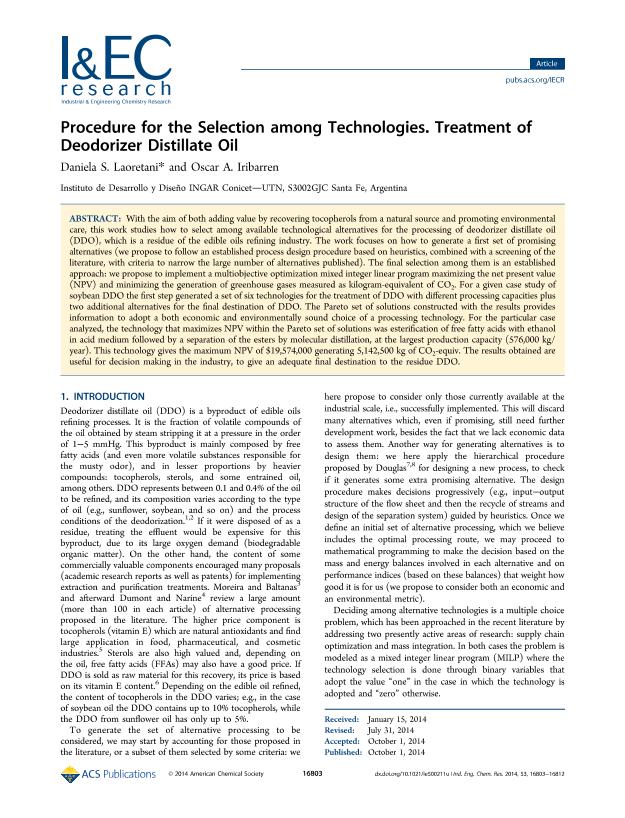Mostrar el registro sencillo del ítem
dc.contributor.author
Laoretani, Daniela Soledad

dc.contributor.author
Iribarren, Oscar Alberto

dc.date.available
2017-08-15T16:53:12Z
dc.date.issued
2014-10
dc.identifier.citation
Laoretani, Daniela Soledad; Iribarren, Oscar Alberto; Procedure for the Selection among Technologies. Treatment of Deodorizer Distillate Oil; American Chemical Society; Industrial & Engineering Chemical Research; 53; 43; 10-2014; 16803-16812
dc.identifier.issn
0888-5885
dc.identifier.uri
http://hdl.handle.net/11336/22466
dc.description.abstract
With the aim of both adding value by recovering tocopherols from a natural source and promoting environmental care, this work studies how to select among available technological alternatives for the processing of deodorizer distillate oil (DDO), which is a residue of the edible oils refining industry. The work focuses on how to generate a first set of promising alternatives (we propose to follow an established process design procedure based on heuristics, combined with a screening of the literature, with criteria to narrow the large number of alternatives published). The final selection among them is an established approach: we propose to implement a multiobjective optimization mixed integer linear program maximizing the net present value (NPV) and minimizing the generation of greenhouse gases measured as kilogram-equivalent of CO2. For a given case study of soybean DDO the first step generated a set of six technologies for the treatment of DDO with different processing capacities plus two additional alternatives for the final destination of DDO. The Pareto set of solutions constructed with the results provides information to adopt a both economic and environmentally sound choice of a processing technology. For the particular case analyzed, the technology that maximizes NPV within the Pareto set of solutions was esterification of free fatty acids with ethanol in acid medium followed by a separation of the esters by molecular distillation, at the largest production capacity (576,000 kg/year). This technology gives the maximum NPV of $19,574,000 generating 5,142,500 kg of CO2-equiv. The results obtained are useful for decision making in the industry, to give an adequate final destination to the residue DDO.
dc.format
application/pdf
dc.language.iso
eng
dc.publisher
American Chemical Society

dc.rights
info:eu-repo/semantics/openAccess
dc.rights.uri
https://creativecommons.org/licenses/by-nc-sa/2.5/ar/
dc.subject
Recovery of Tocopherols
dc.subject
Deodorizer Distillate Oil
dc.subject
Technology Selection
dc.subject.classification
Otras Ingeniería Química

dc.subject.classification
Ingeniería Química

dc.subject.classification
INGENIERÍAS Y TECNOLOGÍAS

dc.title
Procedure for the Selection among Technologies. Treatment of Deodorizer Distillate Oil
dc.type
info:eu-repo/semantics/article
dc.type
info:ar-repo/semantics/artículo
dc.type
info:eu-repo/semantics/publishedVersion
dc.date.updated
2017-08-04T15:35:04Z
dc.journal.volume
53
dc.journal.number
43
dc.journal.pagination
16803-16812
dc.journal.pais
Estados Unidos

dc.journal.ciudad
Washington DC
dc.description.fil
Fil: Laoretani, Daniela Soledad. Consejo Nacional de Investigaciones Científicas y Técnicas. Centro Científico Tecnológico Conicet - Santa Fe. Instituto de Desarrollo y Diseño. Universidad Tecnológica Nacional. Facultad Regional Santa Fe. Instituto de Desarrollo y Diseño; Argentina
dc.description.fil
Fil: Iribarren, Oscar Alberto. Consejo Nacional de Investigaciones Científicas y Técnicas. Centro Científico Tecnológico Conicet - Santa Fe. Instituto de Desarrollo y Diseño. Universidad Tecnológica Nacional. Facultad Regional Santa Fe. Instituto de Desarrollo y Diseño; Argentina
dc.journal.title
Industrial & Engineering Chemical Research

dc.relation.alternativeid
info:eu-repo/semantics/altIdentifier/doi/http://dx.doi.org/10.1021/ie500211u
dc.relation.alternativeid
info:eu-repo/semantics/altIdentifier/url/http://pubs.acs.org/doi/abs/10.1021/ie500211u
Archivos asociados
